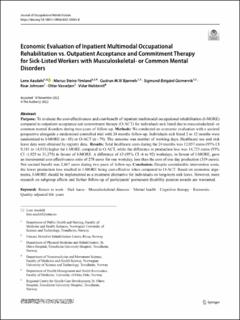| dc.contributor.author | Aasdahl, Lene | |
| dc.contributor.author | Fimland, Marius Steiro | |
| dc.contributor.author | Bjørnelv, Gudrun Maria Waaler | |
| dc.contributor.author | Gismervik, Sigmund Østgård | |
| dc.contributor.author | Johnsen, Roar | |
| dc.contributor.author | Vasseljen, Ottar | |
| dc.contributor.author | Halsteinli, Vidar | |
| dc.date.accessioned | 2023-04-17T06:10:54Z | |
| dc.date.available | 2023-04-17T06:10:54Z | |
| dc.date.created | 2023-03-31T12:56:19Z | |
| dc.date.issued | 2023 | |
| dc.identifier.citation | Journal of occupational rehabilitation. 2023, . | en_US |
| dc.identifier.issn | 1053-0487 | |
| dc.identifier.uri | https://hdl.handle.net/11250/3063221 | |
| dc.description.abstract | Purpose: To evaluate the cost-effectiveness and cost-benefit of inpatient multimodal occupational rehabilitation (I-MORE) compared to outpatient acceptance and commitment therapy (O-ACT) for individuals sick listed due to musculoskeletal- or common mental disorders during two-years of follow-up. Methods: We conducted an economic evaluation with a societal perspective alongside a randomized controlled trial with 24 months follow-up. Individuals sick listed 2 to 12 months were randomized to I-MORE (n = 85) or O-ACT (n = 79). The outcome was number of working days. Healthcare use and sick leave data were obtained by registry data. Results: Total healthcare costs during the 24 months was 12,057 euros (95% CI 9,181 to 14,933) higher for I-MORE compared to O-ACT, while the difference in production loss was 14,725 euros (95% CI -1,925 to 31,375) in favour of I-MORE. A difference of 43 (95% CI -6 to 92) workdays, in favour of I-MORE, gave an incremental cost-effectiveness ratio of 278 euros for one workday, less than the cost of one day production (339 euros). Net societal benefit was 2,667 euros during two years of follow-up. Conclusion: Despite considerable intervention costs, the lower production loss resulted in I-MORE being cost-effective when compared to O-ACT. Based on economic arguments, I-MORE should be implemented as a treatment alternative for individuals on long-term sick leave. However, more research on subgroup effects and further follow-up of participants’ permanent disability pension awards are warranted. | en_US |
| dc.language.iso | eng | en_US |
| dc.publisher | Springer | en_US |
| dc.rights | Navngivelse 4.0 Internasjonal | * |
| dc.rights.uri | http://creativecommons.org/licenses/by/4.0/deed.no | * |
| dc.title | Economic Evaluation of Inpatient Multimodal Occupational Rehabilitation vs. Outpatient Acceptance and Commitment Therapy for Sick-Listed Workers with Musculoskeletal- or Common Mental Disorders | en_US |
| dc.title.alternative | Economic Evaluation of Inpatient Multimodal Occupational Rehabilitation vs. Outpatient Acceptance and Commitment Therapy for Sick-Listed Workers with Musculoskeletal- or Common Mental Disorders | en_US |
| dc.type | Peer reviewed | en_US |
| dc.type | Journal article | en_US |
| dc.description.version | publishedVersion | en_US |
| dc.source.pagenumber | 0 | en_US |
| dc.source.journal | Journal of occupational rehabilitation | en_US |
| dc.identifier.doi | 10.1007/s10926-022-10085-0 | |
| dc.identifier.cristin | 2138863 | |
| cristin.ispublished | true | |
| cristin.fulltext | original | |
| cristin.qualitycode | 1 | |

